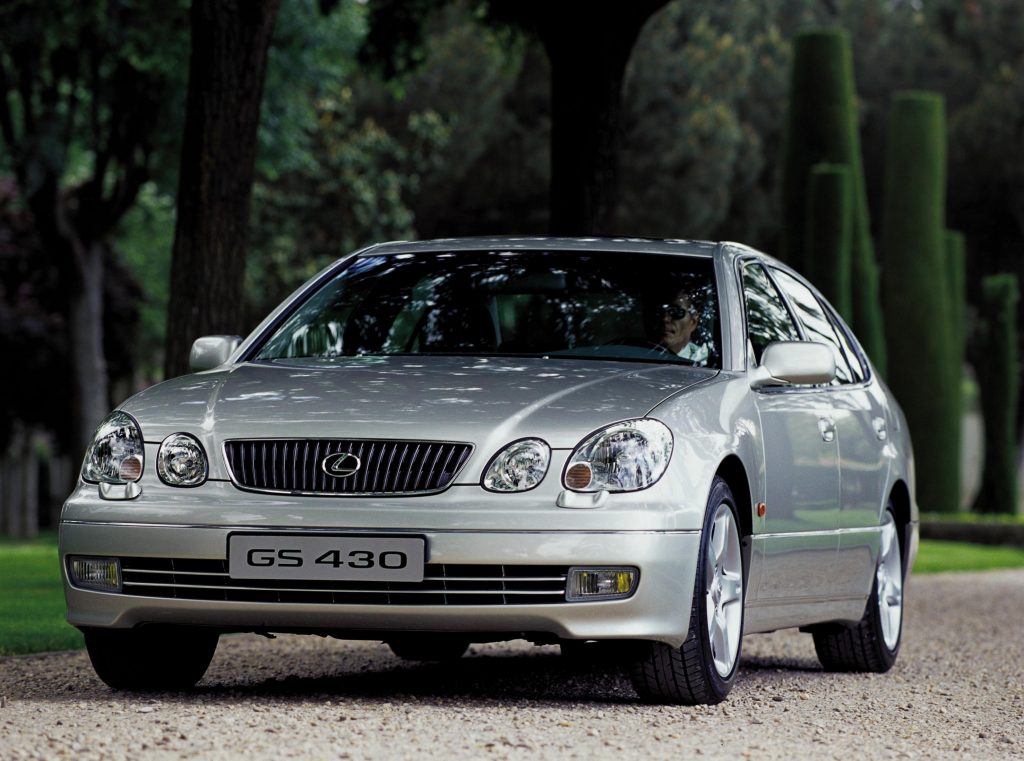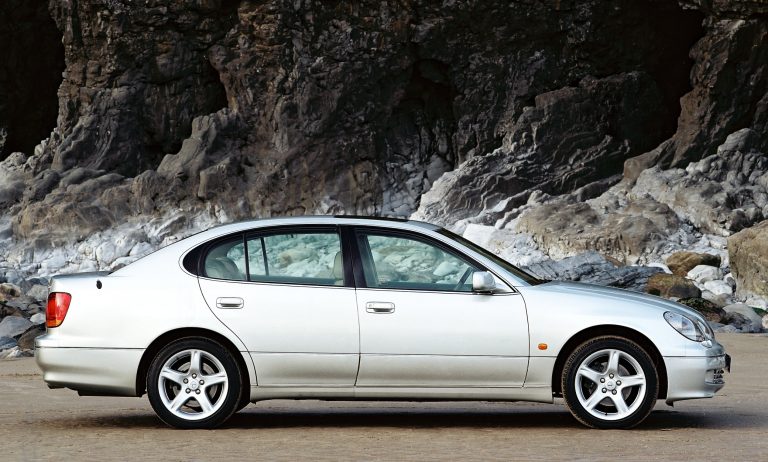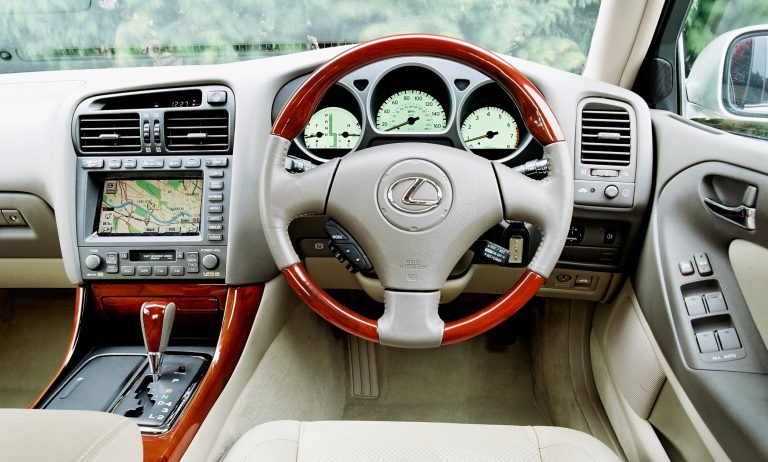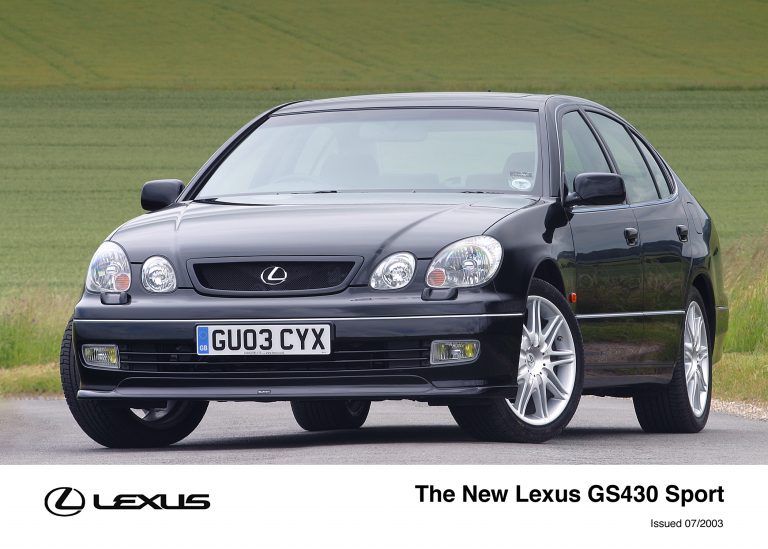Lexus GS430 / GS300 The Appeal Of The Driver’s Car
Paris International Motor Show Press Kit
- GS430 combines legendary Lexus refinement and muscular 4.3 litre, 32-valve, V8 engine with Variable Valve Timing – intelligent (VVT-i) linked to a 5-speed automatic gearbox
- Adoption of E-shift on 5-speed automatic gearbox of GS300, to complement its 3-litre VVT-i engine
- SRS curtain shield airbags added to the already impressive list of safety features (ABS, Vehicle Stability Control, Traction Control and Brake Assist)
- Redesigned radiator grille and rear combination lamps for both models, with different coloured headlight extensions distinguishing between GS430 and GS300 models
- Detail enhancements of stylish, sporting exterior and luxurious, elegant interior
The new Lexus GS430 joins an upgraded GS300 to offer what is truly a driver’s car of the highest dimension. Both combine distinctive style with outstanding performance and the refinement and luxury for which the Lexus brand is renowned, and share some of the most sophisticated automotive technology currently available.
“The GS has been a key model for Lexus. On one hand it has dramatic looks and a sporting appearance. On the other it has the high levels of equipment and refinement associated with a luxury car” said Ian Mathews, Product Manager, Lexus Europe. “It has just got even better with the arrival of GS430, adding yet more passion to the Lexus brand, a great driving experience.”
Engine and Powertrain
The classical combination of front engine, rear wheel-drive chassis and the customary levels of Lexus refinement remain unchanged. However the enhanced powertrain of the Lexus GS430 raises the driving experience to new levels.
The Lexus GS430 is powered by the 3UZ-FE 4.3-litre, V-8 32-valve VVT-i (Variable Valve Timing – intelligent) engine also utilised in the new Lexus LS 430. It develops 283 DIN hp @ 5,600rpm and a maximum torque of 417 Nm at 3,500 rpm.
The Lexus GS300 is powered by the 2JZ-GE three-litre, six cylinder VVT-i engine with 24 valves and twin overhead camshafts to develop 219 DIN hp at 5,800 rpm and a maximum torque of 294 Nm at just 3,800 rpm.
The potential top speed of 155mpm and 0-62mph acceleration time of just 6.3 seconds of the GS430 (143mph and 8.2 seconds for GS300), is sufficient to humble many sports cars, but the big difference is in the refinement and performance of both GS models at all engine speeds.
Both models use Lexus engine management systems which are among the most sophisticated available, controlling fuel injection and ignition timing to thousands of a second. Combined with Variable Valve Timing – intelligent (VVT-i), they give remarkable efficiency, low exhaust emissions and low fuel consumption.
In fact, the GS300 meets Step III emission regulations, and GS430 even meets Step IV. At the same time, the engines also guarantee unrivalled tractability and smoothness.
ACIS (Acoustic Control Induction System): (on GS300 and GS430)
ACIS improves torque over the whole speed range, but especially in the low-speed range, by changing the intake manifold length in three stages. This is done by opening or closing the intake air control valve according to the engine speed and throttle valve angles.
ETCS-i (Electronic Throttle Control System – intelligent): (on GS430 and GS300)
This ETCS-i monitors the engine operating conditions, to supply the optimal amount of torque under any circumstance. This results in smoother acceleration, superior hill-climbing ability and it eliminates jerky starts.
The system works by optimally controlling the throttle valve opening in accordance with the angle of the accelerator pedal and the condition of the vehicle and the engine.
ETCS-i also controls the snow mode, cruise control and is linked to the VSC- (Vehicle Stability Control) and the TRC- (Traction Control) systems.
On GS430, ETCS-i works in synergy with the Torque-Activated Powertrain control.
The Torque Activated Powertrain helps control the torque of the engine, by determining the level of throttle in function of the accelerator position, the engine regime and also the conditions under which the car is driving. As a result, the acceleration is smoother, and a constant speed can be maintained with the slightest movement of the accelerator pedal, also avoiding unnecessary downshifts.
Another feature of the Torque Activated Powertrain is its ability to recognise slopes. On climbing roads, it will increase engine torque to avoid downshifts. When driving downhill, it will select a lower gear in order to provide engine braking. The result is a more relaxing drive, making optimal use of the car’s power and doing away with the discomfort of constant gearchanges.
Intelligent Automatic Gearbox: (on GS430 and GS300)
Both engines are complemented by a Super ECT (Electronically Controlled Transmission) five speed, intelligent automatic gearbox (A650E) which can adapt its gear shift pattern to suit driving style and road conditions.
The transmission is also linked to the computerised engine management system, to momentarily reduce torque for even smoother gear changes. A similar transmission is used on both GS430 and GS300 models, with slight changes in internal construction to suit the output characteristics of the different models.
E-Shift mode on GS300:
A new feature for the GS300 is E-shift, which has transmission shift controls located on the steering wheel. With the floor shift lever engaged in the ‘M’ position, this allows drivers to manually change gear without moving their hands from the steering wheel. A display below the odometer informs the driver of which gear he is in when using the manual mode.
New drive shafts for a more stable ride:
The rigidity of the rear drive shafts has been increased compared to that of the original GS300. Precise development has made it possible to achieve identical rigidity for the left and right drive shaft. As a result, the car’s stability when driving off, under acceleration or when cornering has been improved. And even straight-out stability on roads with low adhesion is better than before. Both GS300 and GS430 benefit.
Reworked suspensions:
Complementing the classical front-engine rear-wheel drive configuration for maximum driving pleasure, the carefully tuned double wishbone suspension system features anti-dive and anti-squat geometry to ensure the best balance of comfort and control, matched to speed-sensitive, rack and pinion power steering. Controllability is further enhanced by the use of low-pressure, nitrogen gas-filled shock absorbers and a thicker, reshaped front stabiliser bar.
The brake-system has been upgraded to deal with the extra power available from the V8-engine in the GS430. However, the main improvements have also been adopted on the GS300. An example is the use of a double master cylinder, incorporated in the brake booster, to ensure top-level stopping power.
Smoothly sculpted, sporting exterior
A key feature of the Lexus GS range is the sporting stance created by its external styling. The profile is based on a simple geometric ellipse which is then given a functional aerodynamic treatment to create what the designers referred to as an “aero-ellipse” shape. This aero-ellipse theme recurs throughout the design and echoes are to be found in the glass covering the headlamps, the rear combination lamps and the window contours.
This distinctive profile, evolved as the result of an extensive programme of aerodynamic development, makes the Lexus GS one of the most efficient shapes of any performance saloon. The low air resistance not only contributes to performance and fuel economy, it also produces greater stability and driver control at speed.
A new radiator grille enhances the nose of the latest GS models, changing the previous form by adding extra body to the upper and lower sections of the vertical bars. The twin sculptured headlamps remain a key feature of the model’s aerodynamic styling, further enhanced by a dark grey top-coat applied to the surface of the extension part of the headlamps of the GS430. A green top coat is applied to the headlight extension of GS300 models.
The tail of the latest cars is equally distinctive, with key features including the traditional Lexus hallmarks of circular rear fog lamps and two individual exhaust outlets, being further enhanced by the use a coloured, semi-transparent outer lamp lenses and reflectors, laid in horizontal bands across the lamp units. This results in a new, fresh look to the GS rear end.
Sixteen inch, six spoke aluminium alloy wheels with a distinctive three-dimensional appearance enhance the sporty appearance of the Lexus GS300, where as the GS430 rides on 17″ five-spoke wheels (optional on GS300). A further refinement is the introduction as standard of water-repellent glass on the front windows of all models. The specially coated glass ensures a rapid dispersal of rain-water to give optimum visibility even in extreme weather conditions.
Interior Innovation and Elegance
The interior of the GS range remains a perfect blend of elegance and practicality, with high-quality upholstery, wood trim and innovative design features. It is also a true Lexus, in offering one of the most peaceful and comfortable environments on the road.
The original Lexus GS300 was recognised as one of the top saloons in its class. The latest models are even better, with further refinements to the suspension, transmission and sound insulation to create even higher standards of cabin refinement.
Subtle changes include the design of the instrument cluster, which along with the central display now feature a grey metallic surround to further reinforce the sporty image. Both GS-versions benefit from the addition of a chromed bezel surrounding the transmission shift lever, where as the GS430 also gets a reprofiled wood and leather steering wheel and the adoption of sculpted real wood for the ash tray receptacle.
Both front seats have electric power adjustment and variable lumbar support which, combined with the electrical multi-adjustable positioning of the leather-bound steering, allows for the perfect driving position. The rear seat can accommodate three people in comfort, with a full three-point seat belt and a headrest provided for the centre passenger.
Standard equipment includes cruise control, double locking and one-touch electrical operation of the windows and sunroof, while the standard air conditioning system provides dual zone temperature control for the left and right sides of the car. It also automatically recirculates airflow when a pollution sensor detects traffic fumes outside the car and now additionally features a deodorising function, which uses a charcoal filter to remove any exhaust gas smell entering the car.
Lexus Navigation:
The optional navigation system utilises a 7.0 inch-wide LCD (liquid crystal display) screen with an infra-red, touch-sensitive panel to offer improved ease of use.
The system has been further enhanced by upgrading from the previous CD (compact disc) to DVD (digital versatile disc) storage. The DVD, which uses a smaller laser beam diameter is able to store approximately about 13 times the volume of data.
This allows for example, the storage of most European countries’ road systems on a single DVD, removing the need to change discs in the system for long-distance travel. The Lexus Navigation system can highlight points of interest, search for a house number or find petrol stations, in addition to showing your exact position at any time on the dashboard screen and guiding you with voice instructions to your selected destination.
The GS’s audio system is purpose-designed for the car and features a fully integrated dashboard unit including radio, Dolby® cassette player and a 6-disc CD autochanger located in the glove box. These feed an acoustically engineered 7-speaker installation for optimum audio quality.
Safety
Extensive use is made of high-tensile steel in the body structure to reduce weight and further enhance efficiency. The body was also carefully designed to maximise the size of impact-absorbing crumple zones in the front and rear as well as incorporating substantial side impact protection bars in the doors.
And then there is a range of additional features that help ensure the safety of those on board:
Anti-lock Braking System (ABS) with Brake Assist (BA):
The GS430 and GS300 are equipped with a four-channel ABS system, that is linked to the cars four disc-brakes. A further significant safety feature is Brake Assist, which interprets a quick push of the brake pedal as emergency braking and supplements the braking power applied to maximise braking performance in conjunction with ABS.
This overcomes a known problem in emergencies of drivers not applying sufficient force to the brake pedal. A key feature of Brake Assist is that the timing and degree of braking assistance is designed to ensure that the driver doesn’t discern anything unusual about the braking operation. When the driver eases up on the brake pedal, the system reduces the amount of assistance it applies.
Traction Control (TRC) and Vehicle Stability Control (VSC):
TRC is fitted to reduce wheel spin under acceleration and to improve tire grip on slippery roads, by reducing the output of the engine and applying the brakes when the system feels that one of the wheels is losing traction.
Driver control is further enhanced by a VSC system. The innovative VSC system monitors the vehicle’s behaviour during cornering and maintains vehicle stability by using the car’s ABS and traction control sensors to correct oversteer or understeer before it occurs by limiting rear wheel spin and lightly applying differential braking on slippery surfaces.
Airbags and Seatbelts:
The new GS430 and GS300 are equipped with dual SRS front airbags and seat mounted side airbags. In addition, SRS curtain shield airbags are now also fitted as standard equipment. Housed in the roof side sections, they inflate at the same time as the side airbags to cover the front window areas.
A sensor determines whether anyone is seated in the front passenger seat, and prohibits the deployment of all airbags for that seat if not. The front seats are equipped with seatbelt tensioners with force limiters.
“Cars like the Lexus GS430 add excitement and emotion to the brand” said Ian Mathews, Product Manager – Lexus Europe. “We have traditionally made some of the best-built, most refined cars in the world. Now we’re offering one of the greatest driving experiences too.”
ENDS





